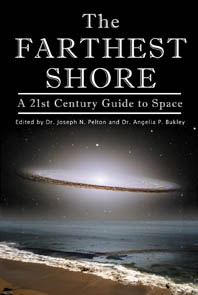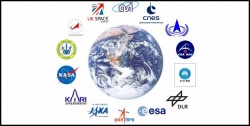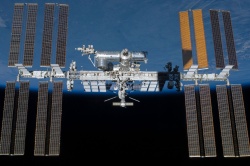The Farthest Shore – Chapter Sixteen The Way Forward
From The Space Library
Chapter Sixteen The Way Forward
Joseph Pelton and Angie Bukley
"… And when [Humanity] … has conquered all the depths of space, and all the mysteries of time, still [we] … will be beginning. -- H.G. Wells, "Things to Come" (1936)
Why should there be space programs? Going into space is complicated, and consumes a great deal of people’s time and energy. We all know that it is still hugely expensive, although “new space” initiatives and small satellite ventures have now dramatically changed many of the cost equations. But we do not go into space solely to satisfy our idle curiosity. Increasingly, we are finding that new space technologies and capabilities represent core capabilities that we need to survive as a species as our global population expands. We must ensure that we have space solutions to the global problems that surely will continue to grow in scope and seriousness.
The truth is that the reasons for going into space are just as numerous as the diverse disciplines that an active space program requires. Here we have learned why and how space is international, intercultural and interdisciplinary. Space is about exploration. It is about science. And it is about an ever-expanding range of applications that helps us to combat global warming, keep our oceans clean, link our world together, provide us instant news, and ensure that many things are truly global—whether it be a Rule of Law, the chance to learn, or the Internet. We now know that space is about much, much more than building and launching rockets. It is truly a mistake to think that space is about a single thing, or a single discipline Space is about the future of humankind and about defining the role of Homo sapiens in the cosmos. In previous chapters of The Farthest Shore we have reviewed, at least to some degree, the following space disciplines and areas of interest:
- The arts, including literature, poetry, the visual arts, dance, plays and movies.
- Astrophysics, astronomy and cosmology.
- Space sciences, the Sun-Earth connection and space weather.
- Space applications, including telecommunications, radio and TV broadcasting, navigation, Earth observation, remote sensing, geomatics, meteorology, search and rescue, and disaster detection, warning and recovery.
- Space transportation, rocketry, satellite design and engineering, and orbital mechanics.
- Space systems engineering, tracking, telemetry, and command systems.
- Space exploration and space habitats.
- Space life sciences and biology.
- Space business and commerce, marketing, entrepreneurship, risk management, capital formation, innovation, and intellectual property acquisition and protection.
- Space law, regulation, policy, and security.
- New space industries and opportunities, including such diverse areas as solar power satellites, new space transportation and space access systems, space tourism, space colonies, space materials, space robotics, mining meteorites, and even terra-forming extraterrestrial bodies.
When people say that space programs are a waste of taxpayers’ money, especially when there are so many vital unmet needs here on Earth, it is important to correct the record. Each year our “eyes in the skies” save tens of thousands of lives, or even more, by warning people of the need to flee from the paths of oncoming hurricanes, typhoons, tropical storms and other natural disasters. Each year satellite search and rescue systems allow hundreds of stranded pilots, fishermen and explorers to be rescued. Without Earth observation satellites, we would not know enough about threats to the ozone layer in the stratosphere that protects all animal and plant life on our planet from extinction by radiation from the Sun and the cosmos. Of even more practical importance are our satellites that monitor pollution, husband water resources, locate key resources, spot crop disease and forest fires, carry out “smart farming”, and combat the most troublesome aspects of global warming.
Scientific satellites and probes such as the Hubble Space Telescope and the Chandra X-Ray Telescope have enabled us to peer into the very depths of the Universe, some 12 billion light years into the past. If all goes well we will have, the James Webb space telescope will tell us more about the structure of galaxies, black holes, quasars, nebulae, and star systems with planets, giving us insight into the Universe and how it works. In future year constellations of observation satellites will achieve even greater resolution. Explorer satellites have revealed amazing details or the residual microwave radio noise from the Big Bang. Surveyor satellites have scurried over the surface of Mars and the Moon to reveal their secrets. Life scientists have used space stations such as Skylab, Mir and the International Space Station (ISS) to understand the mysteries of life in a micro-gravity (near zero gravity) environment.
Until recently, governments and national space agencies have driven progress in space exploration, space sciences and space applications. One of the key reasons that governments invested so significantly in space was for military and strategic purposes, starting with the development of bal-listic missiles. The delicate balance of space-related investment for civil and military purposes has continued now for fifty years. It is ironic that international cooperation in space has been one of the most wonderful opportunities for nations to cooperate together, yet military space programs, by way of contrast, generate international tensions.
Some of humankind’s most elaborate and high profile cooperative programs have been carried in the high frontier of space. Not only has there been the International Space Station, or the Soyuz and Skylab joint mission, but also scores of joint or multi-lateral cooperative satellite programs have been successfully mounted around the world. One of the most successful commercial space program was the Intelsat Global Satellite System that has provided valuable services to nearly 200 countries and territories around the world. It is significant to note that, with the end of the so-called Cold War, many missile systems have been adapted to cooperative purposes to perform civil and commercial satellite launches.
Fourteen space agencies participated in the “Global Exploration Strategy” that provided valuable new information on the health of Planet Earth (see Figure 16.1). The International Space Station, despite its difficulties and cost overruns, remains a testimonial to international cooperation has involved the active cooperation of over twenty space faring nations. These examples and more show that the international dimension of space more often than not pulls the nations of the world together, rather than apart. (see Figure 16.2).
Countless commercial space applications have evolved from telecommunications satellite services. In the 1960s, the success of the global Intel-sat system led to the subsequent deployment of hundreds of commercial satellites, now generating US$ hundreds of billions in revenues each year. Today there are many “spin-off” technologies and applications from space research and development (R&D). These spin-offs are in areas such as advanced construction materials and systems, medical applications, consumer appliances, transportation and communications systems, household goods, robotics and even sporting equipment. Although no commercial space venture has to date been as successful as communications satellites, remote sensing, navigation and geomatics-related applications continue to grow in importance; these aspects of space applications now generate significant commercial revenues. There are currently high hopes that entirely new commercial space ventures, such as space tourism, space habitats, solar power satellites, and even space mining, may one day grow to be multi-billion dollar ventures. Opportunities for many people to “fly into the dark sky”, to experience weightlessness, to see the curvature of Earth, and to witness our planet from space are one of the most exciting opportunities of our times. This is because such experiences increase public awareness that we all live on one small planet and that we inhabit a common biosphere on which all humanity depends. We are, in short, all space travelers.
The vision for space going forward is a large and ambitious one. In future decades space systems may allow us to preserve human, animal and plant life on Earth against the stresses and strains of a global population that exceeds 10 billion people. Future space systems may be needed for reasons that we, today, neither fully understand nor appreciate. We may need important new space capabilities to help us preserve the ozone layer, to reduce the effects of increasing amounts of greenhouse gases, to monitor atmospheric pollution, to protect Earth and global infrastructure from violent solar eruptions, or to restore the oceans to their earlier pristine state.
Only space systems can allow us to have and to operate a unified planetary monitoring system. Future space systems may help us to obtain clean and green energy, to obtain new valuable resources or even to terraform other celestial bodies in space. That would make possible human colonies beyond the Earth’s “gravity well” that holds us close to our home planet— a hold that retards our ultimate destiny.
Our future, both on and off planet Earth, is about people working together. It is about people from North and South America, from Africa and Asia, from the Middle East and Europe, and from Oceania working together to create new knowledge with a new level and spirit of cooperation. Likewise, it is about life scientists and doctors working with engineers and cosmologists. It is about journalists and futurists, and people of arts and letters, working with people in satellite applications and with space lawyers. It is about business people and entrepreneurs working with sociologists, politicians and educators. It is about the synergy that comes from the whole being greater than the sum of the parts.
It is clear is that the exploration and understanding of space remains our long-term destiny. R. Buckminster Fuller, among his many accomplishments, elegantly reminded us that we humans are all space travelers, and that the Earth is our space ship. Let us remember those who chided, or even scolded, Thomas Jefferson when he paid US$ millions, for the Louisiana Purchase, to double the size of the United States. When, in 1867, U.S. Secretary of State William Seward spent even more to acquire Alaska, it was seen as totally crazy acquisition of a worthless icebox. There is, however, no doubt that these investments paid off.
Today, our investment in space is just that, a bet on the future worth of space. With these investments, we are on the cusp of realizing the future potential of humanity and the great value of space-related activities. All the peoples of the Earth need to join together to make the investment, which is essential for creating new technologies and systems. These will be the key technologies required one day to save our species from climate change and extinction, or to meet Earth’s energy needs, or to prevent a meteorite or a coronal mass ejection from catastrophically destroying our civilization. When one invests in the future it is always a gamble. We do not know what the long-term rewards will be. If we look only to tomorrow we will not succeed. We must look to the day after tomorrow to sustain ourselves, and to realize our future dreams. We encourage our readers to join us in our mission. And we must not fail.



